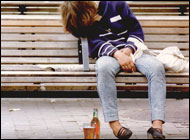Staying active and drinking moderately is the key to a long life
People who drink moderate amounts of alcohol and are physically active have a lower risk of death from heart disease and other causes than people who don’t drink at all, according to new research. People who neither drink alcohol nor exercise have a 30-49 per cent higher risk of heart disease than those who either drink, exercise or both.
The research, which was published in the European Heart Journal [1] today (Wednesday 9 January), is the first to look at the combined influence of leisure-time physical activity and weekly alcohol intake on the risk of fatal ischaemic heart disease (a form of heart disease characterised by a reduced blood supply to the heart) and deaths from all causes.
Between 1981-1983 Danish researchers obtained information on various health-related issues (including exercise and alcohol intake) from 11,914 Danish men and women aged 20 or older, who were taking part in the larger, Copenhagen City Heart Study.
During approximately 20 years of follow-up there were 1,242 cases of fatal ischaemic heart disease (IHD) and 5,901 deaths from all causes among the study participants.
Professor Morten Grønbæk, Director of Research of the National Institute of Public Health at the University of Southern Denmark in Copenhagen, and Professor Berit Heitmann, Director for Research of the Institute of Preventive Medicine at Copenhagen University Hospitals, supervised the research. Prof Grønbæk said: “Our study shows that being both physically active and drinking a moderate amount of alcohol is important for lowering the risk of both fatal IHD and death from all causes. For both men and women, being physically active was associated with a significantly lower risk for both fatal IHD and all-cause mortality than being physically inactive; and drinking alcohol was associated with a lower risk of fatal IHD than abstaining. A weekly moderate alcohol intake reduced the risk of all-cause mortality among both men and women, whereas the risk among heavy drinkers was similar to non-drinkers.”
The lead author of the study, Jane Østergaard Pedersen, a research assistant at the National Institute of Public Health, said: “An important finding from our research for people who have reasons for alcohol abstention such as religious beliefs, previous alcoholism or pregnancy, is that physical activity can reverse some of the adverse health effects associated with alcohol abstention. People who did not drink but whose physical activity was moderate or high, had a lower risk of IHD than the inactive non-drinkers.” 
Physical activity was divided into three categories:
1. physically inactive (less than two hours of light physical activity a week such as reading, watching television, going to the cinema);
2. low level of activity – light physical activity for two to four hours a week (walking, cycling, light gardening, light physical exercise);
3. moderate to high level of physical activity – light physical activity for more than four hours a week or more vigorous activity for two to four hours a week (brisk walking, fast cycling, heavy gardening, sports that cause perspiration or exhaustion), or vigorous physical activity for more than four hours a week, regular heavy exercise, or competitive sports several times a week.
Alcohol intake was classified according to people’s reported total weekly intake, with one drink corresponding to one bottle of beer, one glass of wine and one unit of spirits. Non-drinkers consumed less than one drink a week, moderate drinkers had between 1-14 drinks a week, and heavy drinkers drank 15 or more a week.
Within each level of physical activity, non-drinkers had a 30-31 per cent higher risk of IHD compared to moderate drinkers. However, non-drinkers who had a moderate or high level of physical activity had a reduced risk of IHD of 31 and 33 per cent respectively compared to physically inactive non-drinkers. People who drank at least one drink a week and were physically active had a 44-50 per cent lower risk of IHD compared to physically inactive non-drinkers.
When looking at deaths from all causes (including IHD) the researchers found that within each category of weekly alcohol intake, the physically inactive had the highest risk of death and within each level of physical activity the moderate drinkers had the lowest risk of death from all causes. Compared with physically inactive non-drinkers, being physically active was associated with a 23 per lower risk of deaths from all causes, and being physically active and drinking at least one drink a week was associated with 12-33 per cent lower risk of death.
Ms Østergaard Pedersen said: “The lowest risk of death from all causes was observed among the physically active moderate drinkers and the highest risk among the physically inactive non- and heavy drinkers.”
She concluded: “Neither physical activity alone nor alcohol intake can completely reverse the increased risk associated with alcohol abstention and lack of physical activity. Thus, both moderate to high levels of physical activity and a moderate alcohol intake are important for lowering the risk of fatal IHD and deaths from all causes.”
###
Notes:
[1] The combined influence of leisure-time physical activity and weekly alcohol intake on fatal ischaemic heart disease and all-cause mortality. European Heart Journal, doi:10.1093/eurheartj/ehm574
Contact: Emma Mason
wordmason@mac.com
44-077-112-96986
Oxford University Press